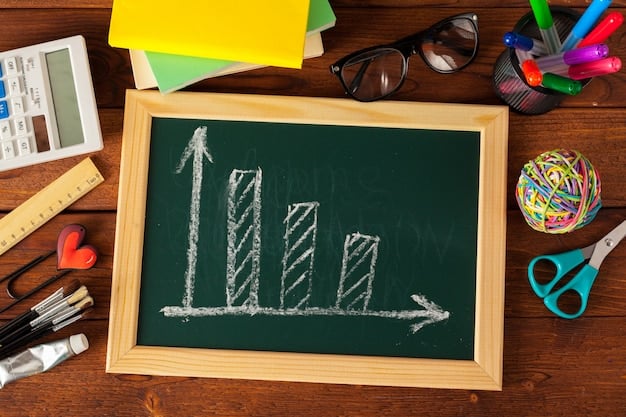Student Loan Repayment 2025: Income-Driven Plans & Forgiveness Guide

Navigating student loan repayment in 2025 involves understanding income-driven repayment plans and potential forgiveness programs, crucial for borrowers seeking affordable payment options and long-term financial relief.
Are you feeling overwhelmed by the prospect of navigating student loan repayment in 2025? Understanding the intricacies of income-driven repayment (IDR) plans and potential loan forgiveness programs can provide a pathway to manageable payments and long-term financial stability.
Understanding the Landscape of Student Loan Repayment in 2025
The student loan repayment landscape is constantly evolving, making it essential to stay informed about the latest changes and options available. As we approach 2025, borrowers need to understand the current state of repayment plans, potential legislative updates, and the impact of economic factors on their loan obligations.
Current Repayment Plan Options
Several standard and income-driven repayment plans are available to federal student loan borrowers. Each plan has different eligibility requirements, payment structures, and potential for loan forgiveness.
- Standard Repayment Plan: Fixed monthly payments over a 10-year period.
- Graduated Repayment Plan: Payments start low and increase every two years, typically over a 10-year period.
- Extended Repayment Plan: Fixed or graduated payments over a period of up to 25 years.

Legislative and Economic Influences
Legislative changes and economic conditions can significantly impact student loan repayment. Monitoring these factors is crucial for borrowers to anticipate potential changes and adjust their repayment strategy accordingly.
- Stay informed about any potential student loan forgiveness programs or policy changes.
- Understand how economic factors such as inflation and interest rates can affect your loan payments.
- Keep up with updates from the Department of Education and other relevant agencies.
Understanding the current landscape sets the stage for making informed decisions about choosing the right repayment plan and taking advantage of available opportunities.
Navigating Income-Driven Repayment (IDR) Plans
Income-driven repayment (IDR) plans are designed to make student loan payments more affordable by basing the monthly payment amount on your income and family size. These plans can be a valuable option for borrowers who are struggling to manage their loan payments under standard repayment plans.
How IDR Plans Work
IDR plans calculate your monthly payment based on a percentage of your discretionary income. This discretionary income is typically defined as the difference between your adjusted gross income (AGI) and a certain percentage of the poverty guideline for your family size and state of residence.
There are several types of IDR plans, each with its own specific rules and eligibility requirements. Some of the most common IDR plans include:
- Income-Based Repayment (IBR): Caps monthly payments at 10% or 15% of discretionary income, depending on when the loan was disbursed.
- Pay As You Earn (PAYE): Caps monthly payments at 10% of discretionary income and requires that the borrower is a new borrower.
- Revised Pay As You Earn (REPAYE): Caps monthly payments at 10% of discretionary income and is available to almost all borrowers with eligible federal student loans.
Choosing the Right IDR Plan
Selecting the most suitable IDR plan requires careful consideration of your financial situation, loan types, and long-term goals. Factors to consider include:
- Compare the different IDR plans and their eligibility requirements.
- Use online tools and calculators to estimate your monthly payments under each plan.
- Consider your long-term career prospects and potential income growth.
Careful analysis helps borrowers choose the IDR plan that best aligns with their financial needs and repayment goals, providing a manageable path to paying off their student loans.
Exploring Potential Student Loan Forgiveness Programs
Student loan forgiveness programs offer a pathway to having a portion or all of your student loan debt discharged after meeting certain requirements. These programs can provide significant relief for borrowers who qualify, reducing their overall debt burden.
Public Service Loan Forgiveness (PSLF)
The Public Service Loan Forgiveness (PSLF) program is designed for borrowers who work full-time in eligible public service jobs. Eligible employment includes working for a government organization, a non-profit organization, or certain other types of public service organizations.
To qualify for PSLF, borrowers must make 120 qualifying monthly payments while working full-time for an eligible employer. The payments must be made under a qualifying repayment plan, such as an income-driven repayment plan.
If all requirements are met, the remaining balance of the borrower’s Direct Loans will be forgiven after the 120th qualifying payment.
Teacher Loan Forgiveness
The Teacher Loan Forgiveness program is available to eligible teachers who teach full-time for five consecutive academic years in a low-income elementary or secondary school. Depending on the subject they teach, teachers may be eligible for up to $17,500 in loan forgiveness.

To qualify, teachers must have Direct Loans or Federal Family Education Loan (FFEL) Program loans. They must also meet certain other requirements, such as having a bachelor’s degree and being highly qualified under state standards.
Exploring forgiveness programs is crucial for those in eligible professions, offering a potential avenue to alleviate student loan debt and achieve long-term financial security.
Strategies for Optimizing Your Repayment Plan in 2025
Optimizing your repayment plan involves taking proactive steps to ensure that you are making the most of your financial situation and the available repayment options. This includes exploring strategies to lower your monthly payments, accelerate your repayment, and manage your overall debt.
Refinancing Your Student Loans
Refinancing your student loans can be a strategic way to lower your interest rate and reduce your monthly payments. When you refinance, you take out a new loan to pay off your existing student loans. The new loan may have a lower interest rate, a different repayment term, or both.
- Shop around for the best interest rates and terms from multiple lenders.
- Consider whether a fixed-rate or variable-rate loan is best for your situation.
- Be aware that refinancing federal student loans into a private loan means you will lose access to federal benefits, such as income-driven repayment plans and loan forgiveness programs.
Making Extra Payments
Making extra payments on your student loans can help you pay off your debt faster and save money on interest. Even small extra payments can make a significant difference over time.
Optimize your repayment strategy by considering these steps:
- Set up automatic payments to ensure you never miss a payment and potentially qualify for an interest rate discount.
- Consider making bi-weekly payments instead of monthly payments to accelerate your repayment.
- Use windfalls, such as tax refunds or bonuses, to make extra payments on your loans.
By actively managing your repayment plan, borrowers can achieve their financial goals more efficiently and effectively.
Common Pitfalls to Avoid
Navigating student loan repayment can be complex, and it’s easy to make mistakes that can cost you time and money. Being aware of common pitfalls and taking steps to avoid them is essential for managing your student loan debt effectively.
Ignoring Your Loan Documents
One of the biggest mistakes borrowers make is ignoring their loan documents. Your loan documents contain important information about your loan terms, interest rates, repayment options, and eligibility requirements for forgiveness programs.
To stay informed and avoid surprises, you should:
- Read your loan documents carefully and make sure you understand all the terms and conditions.
- Keep your loan documents in a safe place and refer to them as needed.
- Contact your loan servicer if you have any questions or concerns about your loan.
Falling Behind on Payments
Another common pitfall is falling behind on your loan payments. Missed payments can result in late fees, damage to your credit score, and even default.
- Set up automatic payments to ensure you never miss a payment.
- Contact your loan servicer immediately if you are having trouble making your payments.
- Explore options such as forbearance or deferment if you need temporary relief from your loan payments.
Avoiding these pitfalls can help borrowers maintain good standing on their loans and avoid unnecessary financial stress.
Resources and Tools for Debtors
Numerous resources and tools are available to help borrowers navigating student loan repayment in 2025. Utilizing these resources can provide valuable support and guidance, ensuring borrowers make informed decisions about their repayment plans and financial futures.
Online Calculators and Budgeting Tools
Online calculators and budgeting tools can help borrowers estimate their monthly payments, compare different repayment plans, and track their progress towards paying off their debt.
Available resources include:
- The Department of Education’s loan simulator.
- Personal finance websites like NerdWallet and Bankrate.
- Budgeting apps like Mint and YNAB (You Need a Budget).
Reputable Credit Counseling Services
Reputable credit counseling services can provide personalized advice and support to borrowers struggling with debt management.
These services can help:
- Assess your financial situation and develop a budget.
- Explore your repayment options and choose the right plan for your needs.
- Negotiate with your loan servicer to lower your interest rate or monthly payments.
Leveraging these resources empowers borrowers to take control of their student loan repayment and build a solid financial foundation.
| Key Point | Brief Description |
|---|---|
| 💰 IDR Plans | Income-Driven Repayment plans base monthly payments on income and family size. |
| 💼 PSLF | Public Service Loan Forgiveness forgives loans after 120 qualifying payments in eligible public service jobs. |
| 👩🏫 Teacher Loan Forgiveness | Teacher Loan Forgiveness offers up to $17,500 for teaching five consecutive years in low-income schools. |
| 🏦 Refinancing | Refinancing can lower interest rates and monthly payments, but federal benefits may be lost. |
Frequently Asked Questions
▼
Income-driven repayment (IDR) plans are federal student loan repayment options that base your monthly payment on your income and family size. They can significantly lower your payments.
▼
To qualify for PSLF, you must work full-time for an eligible employer, such as a government or non-profit organization, and make 120 qualifying monthly payments.
▼
REPAYE is an income-driven repayment plan that caps your monthly payments at 10% of your discretionary income and is available to most borrowers with federal student loans.
▼
Yes, you can refinance your federal student loans with a private lender, potentially securing a lower interest rate. However, you’ll lose federal benefits like IDR plans and PSLF.
▼
If you can’t afford your payments, contact your loan servicer immediately to discuss options like forbearance, deferment, or switching to an income-driven repayment plan.
Conclusion
As you prepare to navigating student loan repayment in 2025, remember that understanding your options and staying proactive are key. By exploring income-driven repayment plans, potential forgiveness programs, and strategies like refinancing, you can create a manageable path to financial stability and achieve your repayment goals.





